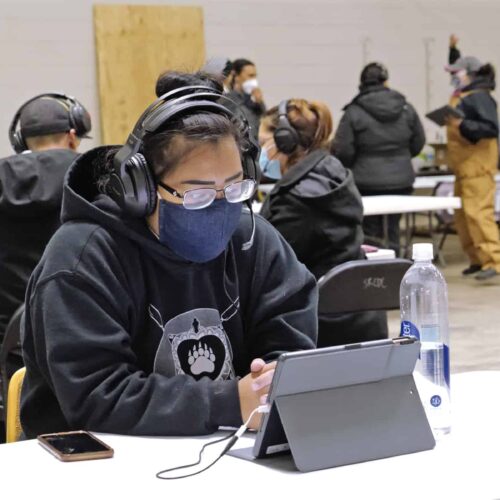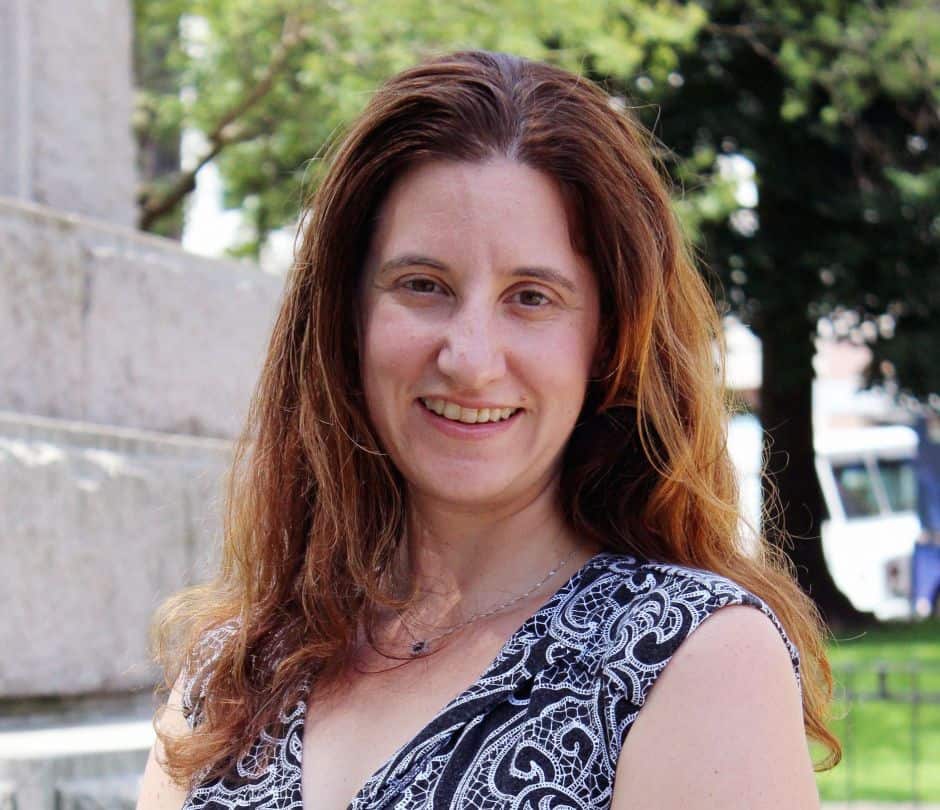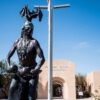Introduction
Leatrice Hendricks had 90 minutes to turn in absentee ballots from the Standing Rock Sioux Tribe’s reservation to the clerk’s office in Corson County, South Dakota.
She had stopped by 25 homes where fellow tribal members were quarantined with COVID-19, driving for hours to get the ballots to them. Hendricks waited outside as voters filled them out.
“I think I filled up my gas tank three times already,” Hendricks said Monday as she stopped at one of the homes on her list. It was about 3:30 p.m., and she needed to deliver the ballots to the clerk’s office by 5 p.m. in the town of McLaughlin — a half-hour drive away. She still had a few more homes to visit.
COVID-19 has disproportionately hit Native Americans, adding to a long list of obstacles to voting in many tribal communities: high rates of poverty, long distances to polling places, limited access to transportation, slow and/or limited U.S. Postal Service delivery, and voter registration and voter ID laws that don’t recognize nontraditional addresses on tribal land.
Some traditional turnout efforts, such as carpooling or offering bus rides to the polls, weren’t possible this year because of the pandemic. Hendricks was working for a new partnership between the Standing Rock Sioux Tribe and the nonprofit Lakota People’s Law Project to find new ways to get out the Native vote. The lessons organizers have learned this year could renew efforts to dismantle some of the longstanding barriers that Native Americans face at the ballot box.
“All of these current barriers don’t exist as stand-alone barriers,” said Rosemary Avila, the Arizona campaign manager for All Voting is Local, a nonprofit voting rights group. “They are connected to a long, historical string of problems that have disenfranchised Native American voters.”
Arizona, for example, long required voters to pass a strict literacy test in order to register to vote, which kept many Apache and Navajo voters from participating in its elections. More recently, the state has tried to ban civic groups from picking up and delivering ballots for voters — a common practice on tribal lands.
The U.S. Supreme Court has agreed to review a legal challenge to the law. In North Dakota in 2018, the U.S. Supreme Court allowed a long-delayed photo identification law to go into effect shortly before the midterm elections, though a federal judge had blocked it after finding the requirements would fall disproportionately on Native Americans. Lawsuits over the requirement ended in a settlement earlier this year. In South Dakota, a tribal identification card isn’t valid for voter registration purposes.
Native Americans make up a small share of the U.S. population (about 1.7%, according to the National Congress of American Indians), but their votes have proven decisive in past Senate races in Montana, North Dakota and Alaska. In Arizona, a swing state where the presidential race hinged on a tiny fraction of votes, they represent 6% of the voting-age population.
But Native American voter turnout has lagged for years, something advocates are trying to change.
“If you took away their roads, gave them poverty, no transportation, and added in distance, the white vote would plummet,” said O.J. Semans, co-executive director of Four Directions, a South Dakota-based nonprofit that advocates for voting rights and was active this year in Arizona, South Dakota, Nevada and Minnesota.
This election, because of the pandemic, Four Directions recruited drivers on reservations to take relatives to the polls.
The North Dakota side of Standing Rock, a 2.3 million-acre reservation that spans the border between the Dakotas, was the focal point of a voting rights battle two years ago. This year, with no high-profile Senate race, it drew less attention. About 40 workers, including Hendricks, helped Standing Rock voters secure photo IDs and assisted tribal members in registering or voting by mail — no small challenge on a reservation where towns are a half-hour drive or more from the nearest post office.
Phone bank workers called every active voter with a phone on Standing Rock, as well as thousands of voters in Arizona, North Carolina and Florida, according to Jesse Phelps, a spokesman for the Lakota People’s Law Project. When the pandemic worsened, phone bank workers began working from home. Phelps said his group hopes to continue the effort.
“We believe it is a super effective model that can easily be replicated and honed to make an even bigger difference going forward,” Phelps said.
Lessons learned
On Oct. 22, the Navajo Nation hit a grim milestone. The sprawling reservation, parts of which are in Utah, Arizona and New Mexico, reported 11,101 COVID-19 infections and 574 deaths since the pandemic began — a higher per capita death rate than any U.S. state.
But the election loomed. Katherine Belzowski, an acting assistant attorney general at the Navajo Nation Department of Justice, said Navajo Nation representatives worked with local county governments to request more early voting sites and drop boxes, something many — though not all — of the Arizona counties were willing to provide. Other Arizona tribes also asked counties for more resources, with mixed success.
As a result, she said, more Navajo Nation residents than before appear to have cast mail-in ballots and many voted early. On Election Day, she said, the only reports of lines in the Arizona part of the reservation were at two Apache County locations in Chinle and Red Mesa. Both stayed open for an additional hour after the Navajo Nation filed a lawsuit seeking it.
But two New Mexico counties declined to provide more than the usual resources to the reservation, Belzowski said, in part because her office “probably should have asked sooner.”
It’s a lesson learned, and a mistake she said she won’t make again. “It really is going to make us pay a lot more attention to New Mexico for the next election cycle,” Belzowski said.
Native Americans in Utah, Montana, New Mexico and Wyoming are dying from the coronavirus at a rate five times higher than the general population.
As the pandemic spread, New Mexico counties opened fewer polling locations to serve Native voters during the June primary. In all, the state had 21 fewer early voting sites and 167 fewer polling stations open during the primary than in 2018, according to the University of New Mexico’s Center for Social Policy. Voting rights groups were also unable to register young voters at public events as they normally do.
The obstacles may have contributed to a 1% drop in turnout among Native Americans in the state during the primary, while the rest of the state saw an 8% increase in turnout, according to Common Cause New Mexico. These challenges may have lowered turnout during the general election, too, though the data is not yet available.
Amber Carrillo, Native American voting rights organizer for Common Cause, said she was surprised that many Native voters requested absentee ballots, which her group had encouraged this election cycle. Organizers called voters and bought ads on social media targeting zip codes in Indian Country, telling them that voting by mail was the best option.
“We discovered that a majority did move to mail-in voting and that it can be a good option for [Native] voters,” Carrillo said, adding that there were few reports of problems with absentee voting this year.

Native turnout efforts
On Election Day, seven volunteers were fielding calls to the Arizona Native Vote Election Protection hotline. They answered questions in English, Hopi, Navajo and Apache. Volunteers helped voters find their polling places and checked to see if voters’ absentee ballots were counted. While there were more calls about voter intimidation than in past elections, none of the problems seemed to keep voters from getting to the polls, said Patty Ferguson-Bohnee, director of the Indian Legal Clinic at Arizona State University, which oversaw the voter tip line.
She and 100 field workers visited polling places in tribal precincts on Election Day, and they reported longer lines than usual. She said that made her optimistic about voter turnout this year but said it’s also a sign that counties need to open more polling locations to serve Native voters in future elections.
“These are systemic issues that need to be addressed that are not the fault of the voter,” she said. “We have known about them for more than a decade and we have more work to do.”
As of Thursday, voters on tribal lands had helped elect six Indigenous candidates to the U.S. House of Representatives, sending a record number of Native Americans to Congress next year. Four were reelected and two are new: Native Hawaiian Kaiali’i Kahele and Yvette Herrell, a Cherokee from New Mexico.
Correction: Nov. 9, 11:30 a.m.: Previous photo captions referred incorrectly to the location of the Standing Rock reservation. It is in North and South Dakota.
Read more in Money and Democracy
Barriers to the Ballot Box
Trump-backing nonprofit gave millions to groups registering voters in swing states, tax filing shows
In Florida and North Carolina, the nonprofits drew scrutiny from authorities.
Barriers to the Ballot Box
Across the country, voters remove racist symbols and language from founding documents
The summer of unrest sharpens the nation’s attention to issues of racial justice.




Join the conversation
Show Comments